
Fokker EIII - $$4.50
The E.III was basically an E.II fitted with larger, newly designed wings and it was a far greater success than the E.II. It retained the same 100 hp Oberursel U.I engine but had a larger 21.5 gal main fuel tank which increased the Eindecker's endurance to about 2½ hours; an hour more than the E.II.
Eindecker Fokker EIII WWI German Scout
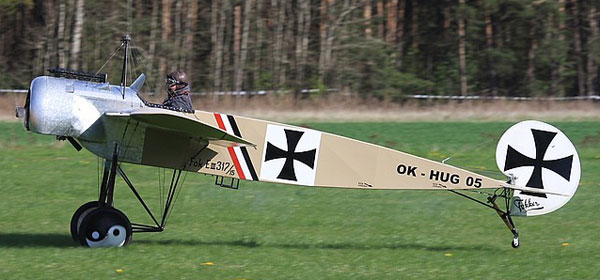
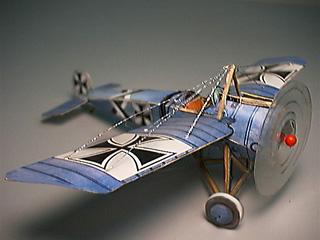
Tony Fokker is said to have invented the 'shoot through the prop' machine gun and this sweet little airplane became the first killer fighter. (a great explanation about how he did that is on the back of the card). This was the reason for the famous Fokker Scourge. Max Immelmann did a loop/roll in one and the 'Immelmann Turn' was invented.
During the early months of the war the Fokker Aeroplanbau directed by the young Dutchman Anthony Fokker supplied three operational monoplane types to the German Forces. They were the M 8, M 5 L, and M 5 K (military designations A-I, A-Il and A-Ill).
I have a picture of the first of your models I built, which must be getting on for ten years old now, I'd like you to see. I re-rigged it with nylon monofilament instead of the original cotton but other than that it has stood up to the rigors of its life pretty well.
Looking forward to doing business with you, regards, Derek (Dec 27,00)
Fokker E-I,E-II,E-III, and E-IV
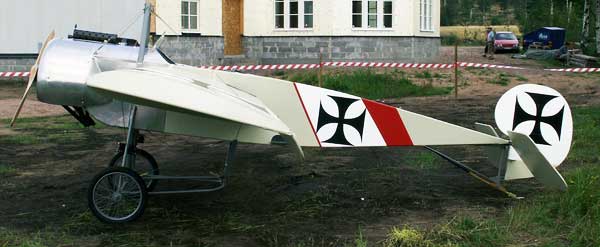
During the early months of the war the Fokker Aeroplanbau directed by the young Dutchman Anthony Fokker supplied three operational monoplane types to the German Forces. They were the M 8, M 5 L, and M 5 K (military designations A-I, A-II and A-III).
On April 19th, 1915. the well-known French pilot Roland Garros fell into German hands; his Morane was found to have a fixed machine-gun firing forwards through the airscrew arc. There was no synchronizing gear; steel wedges fitted to the airscrew deflected any bullets which might have damaged it. Crude though this device was, the German authorities realized its potentialities, and asked Fokker to supply an aeroplane with a similar type of armament.
The result was the interrupter gear rapidly devised and built by Anthony Fokker and Lubbe in July 1915. It was by no means the first of its kind, for interrupter gears had already been patented; in Germany by Frani Schneider, the L.V.G. designer, and in Britain by the Edwards brothers; it was, however, the first gear to be given active Government support.
The aeroplane in which it was installed was the MS K. the single-seater
monoplane already in service. After being armed and modified,
it was designated the MS K/MG (MG meant Mechinengewehr or machine-gun);
its military title was the Folker F-I.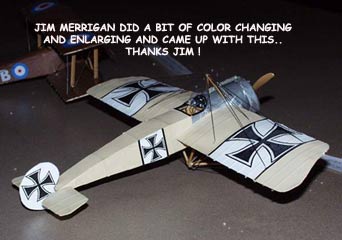
The E-I had the 80 h.p. Oberursel rotary engine, partially enclosed in an aluminum 'horseshoe' cowling. The fabric-covered wings were of composite construction; twin wooden spurs. wooden ribs and steel-tube compression members. The front-wing cables gave rigid bracing; the rear cables controlled the warping of the wing extremities from cranks under the fuselage. The upper control cable' ran over a pulley wheel at the apex of the steel-tube fuselage pylon. The fuselage was framed in wire-braced welded steel tubing, fabric-covered except for metal panels from cowling to cockpit. The balanced elevators and typical Fokker comma-shaped balanced rudder were framed in steel tubing. The undercarriage was a complicated arrangement of steel tubes; the elastic shock absorbers were inside the fuselage at the top of the main vertical struts.
At first a Para bellum gun was fitted, but the standard armament was a Spandau gun fixed slightly to starboard.
The E-T was underpowered and soon replaced by the E-II and E-III. (both designated M14) bigger machines with the l00 hp. Oberursel.
Most of the Fokker monoplanes constructed were of these types they were not outstanding aeroplanes, but their synchronized guns made them most formidable against the slow, ill-armed Allied machines. The Fokkers were used entirely in addensive role: one or two being attached to each reconnaissance unit. The new methods of single seater fighter attack were successfully evolved by such pilots as Immelmann, Boelcke, and Wintgens.
The E-IV was a larger machine, powered by the 160 h.p. two-row
Oberursel. and armed with two guns. The engine proved to be unreliable
and few were built. About twenty Fokkers (serialized approximately
from 03.40 to 0359) were used by Austro-Hungary.
Anthony Fokker was born in Java, in the then remote Netherlands
East Indies. His father was a more-than-prosperous coffee planter,
and young Anthony was more than happy running wild and barefoot
with the native boys across the coral sands. In 1897, when he
was six, his family returned to Holland, principally so that he
could go to school. But young Fokker spent most of his time in
the attic, which he converted to a workshop, and where he constructed
his own model electric railroad, carefully wiring the doorknob
into the high-tension circuit, so he would not be intruded upon.
At school he modified his desk so that it contained an aide-memoire
remotely operated and invisible to his teachers. He devised a
pen that would write four "lines" at once, so that "one
hundred lines" could be rattled off as twenty-five. He must
have been a poisonous small boy-cocky, arrogant, selfish. After
four years of inconclusive battle, he dropped out of school, announcing
his intention to develop a new kind of tire in which coil springs
replaced air and rubber. It must have been the first and last
time the world got the better of Anthony Fokker, for a lawyer,
hired with a fair amount of Fokker senior's money, finally announced
that such a device was already thoroughly patented by another
inventor. Young Fokker was next drafted into the army, but soon
malingered his way out.
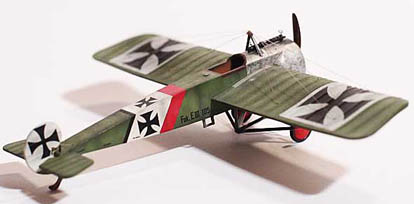 |
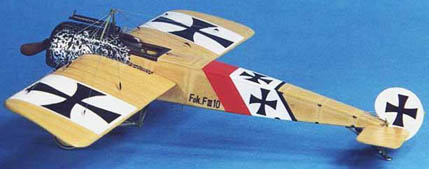 |
Gary Dare did a green version of the Fokker E-III. He did the texture painting on the cowling on the green one as on the yellow one, as well as colored the cockpit and engine.
|
|
One day he went to an automobile show in Brussels where Hubert Latham's airplane was one of the exhibits. "You may do as you please," said Fokker senior, with the rich disgust of all rich fathers of problem sons, "but I will never buy you an airplane." Young Anthony retired to his attic and experimented with wood and paper models. Sweep back and enough dihedral, he found, could confer perfect lateral stability, so that no roll control or wing warping was required.
But downstairs his exasperated
parents were planning a career for him. He was to go to an engineering
school in Germany. Soon young Fokker was aboard a Rhine steamer
and on his way, weeping from homesickness. Next he was badgering
his father for the money to transfer to another engineering school
twenty miles away. It was not till later that his father found
out it was a school of aeronautical engineering. His parents held
the widely prevalent view of the time that flying was no more
than the shortest route to the cemetery. The school designed and
built an airplane as an exercise, and it crashed with the aviation
instructor on its first flight. Once more Anthony Fokker wept.
Unabashed, he wrote to his father for more money, to build a flying
machine of his own. Much to his surprise, back came 1,000 marks
without a murmur of protest. It was only the beginning. 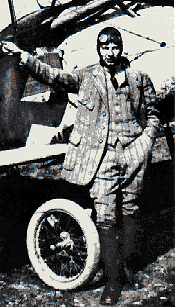
Poor dad was to shell out no less than 183,000 marks before his son's lust for aviation became profitable. Old Herman, Fokker senior, rather delighted in playing curmudgeon. When his neighbors in Haarlem said, "There's old Mr. Fokker," he would rattle his dentures and growl, "The devil is old, too." Some of his son's begging letters, masterpieces of artifice and youthful conceit, survive, along with his father's choleric annotations of "Nonsense" and "Big words" and "Never" and the like. But he kept right on paying, and in later years allowed that he knew how young men needed capital, and that he himself had been an even worse failure at school than his son. Fokker senior's doubts were confounded in the early war years when '33 his son not only repaid every penny with interest, but declined his patrimony; whatever he might need thereafter, it would never again be money from his father.
Anthony Fokker's first airplane was shared with a partner, who waited till Fokker went off home to visit his parents at Christmas, then took it out alone and wrecked it. It was the last time Fokker encumbered himself with partners.
Fokker's early airplanes were all called "Spin" (Spider), and all embodied the principles of automatic stability he had discovered through his model experiments. There was not much to them: an engine, usually salvaged from the wreck of a previous airplane; a sled like tripod of skids to which the wheels were attached; tilted, fabric-covered wings; and welded tubes and wires and turnbuckles that ran aft to form the stabilizer, and rose high above the motor to form king posts for the wings. Everything was cut and fitted very much by eye; Fokker had a flair for this kind of improvisation. In those days, if you were an aviator you were all things to all men. Anthony Fokker conceived and built his flying machines, sold them where he could, gave flying lessons, flew for a share of the gate before crowds every weekend, borrowed money, and spent it-and unsuccessfully sought orders for his machines from all the armies of Europe. It was a rough-and-tumble business, where courage counted for more than kindness. The crowds came to see men die, and die they did. Fokker himself had a bracing wire let go one day at 2,400 feet and rode his / disintegrating machine down to the treetops. He survived almost unhurt, passenger died in the smash.
Fokker was also the first man ever to loop an airplane in Germany. "So I set my teeth," he later described it, "and thought, 'Some day you must die. It might as well be now.'"
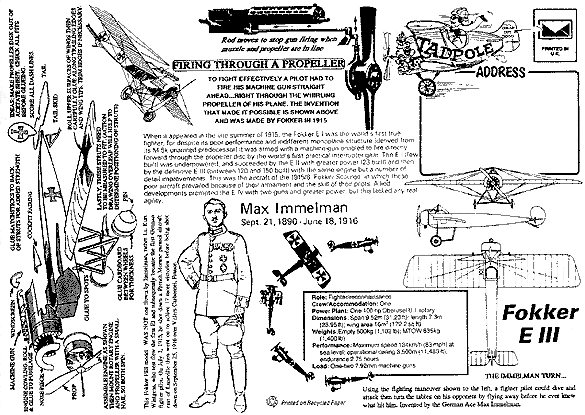
It was a hand-to-mouth existence to be thus driven to a desperate courage by pride and the promises of air-show promoters. But the devil takes care of his own, and Fokker, who should have been killed ten times over by his own admission, survived. When the tide of his fortunes turned, it caught him by surprise, for he never expected war. It turned dramatically. Within hours those same officers of the German army and navy to whom he had endlessly and fruitlessly demonstrated his machines were bidding for them like crazed collectors at a mad auction. (It mattered not to Fokker who bought his services. He was a neutral, and a businessman, not a moralist.) In a day or two Fokker had sold everything in his shop-whether it flew or not, whether it was his or not, at any price he cared to mention. Everyone was certain the war would be over in three months; one had to seize opportunities as they presented themselves.
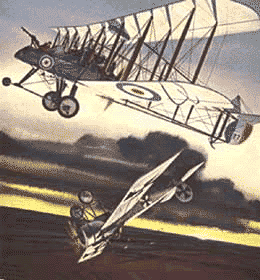
But three months came and went, and still there was war. German reconnaissance airplanes began mysteriously to disappear, and on April 15, 1915, when a French Morane-Saulnier monoplane was forced to land behind their lines, the Germans found out why. Strapped to the fuselage top was a Lewis gun, and carefully lined up with it on the propeller blades were heavy steel deflector plates. In this way the airplane had become a flying gun that could be aimed at its target simply by the pilot moving his flying controls.
Blinkered by the conservatism of their calling, the commanders of the German air service had no thought but to imitate the Morane's gun, and summoned Fokker, whose airplanes they already liked, to do the job. At five o'clock one Tuesday evening he was given a Para bellum machine gun to experiment with.
Fokker had never even handled a gun before, but he knew at once that deflector plates on the propeller were a poor solution to the problem. Two days and two nights later, pale from lack of sleep, he had the answer strapped to his car, and set off for Berlin. The answer was a little Fokker monoplane with a machine gun mounted atop its fuselage just like the French airplane, but with its firing mechanism connected to the propeller by a rod-and cam arrangement so that fire was interrupted whenever a blade of the propeller turned past the gun's muzzle.
At first the German officers didn't believe it. Fokker started his engine and fired a few shots without one catching the propeller. There must be some trick to it, they thought. Would Herr Fokker care to fire a belt of one hundred bullets from the air? A target was set up on the turf and Fokker dived on it with his guns blazing. To his contemptuous delight the bullets ricocheted everywhere, as did the German officers, rushing madly for cover and throwing themselves flat on the earth. When they had picked themselves up and dusted off their uniforms their minds at last were clear on what they must do. They must pass the buck. Would Herr Fokker care to demonstrate his invention to the officers at the front? So Fokker once more lashed the little monoplane to the back of his car and Set off for the front. There the officers didn't believe his synchronizing device, either. Perhaps he would care to demonstrate it to the Crown Prince, who was in residence only a few miles away? Fokker performed a few of his favorite aerobatics, then dived on the field and fired a burst into the stream that bordered it. Even he did not have the gall to make the Crown Prince of Germany run for cover. Very interesting, said the Crown Prince. It was perhaps Herr Fokker's father who invented the device? For Fokker was only a boyish twenty-four. People were always asking him for Herr Direktor or the real Herr Fokker. "You seem to be a real Flying Dutchman," the Crown Prince admitted, asking Fokker back for lunch and some of his special sherry. But Fokker did not drink. His only weakness was candy.
Still no one would make a decision. Perhaps Herr Fokker would care to shoot down a Frenchman to prove that his synchronized gun really works in combat: So for several weeks Fokker, uncomfortable in a German uniform, patrolled the skies of northeastern France till he stumbled upon a lumbering two seater Farman observation biplane. He crawled up behind it, took aim, and decided suddenly that the whole job could go to hell. Let them do their own killing! He returned to the German field at Dubai. There was an argument, but in the end it was agreed Lieutenant Oswald Boelcke would take on the job. On his third flight Boeleke, who was later to become the first German ace, scored. The entire German air corps was at once convinced that Fokker was a genius. He was deluged with orders for the gun-synchronizing device and for his monoplane. Lieutenant Max Immelmann received the second Fokker that was ready, and he too scored at once. Within a week or two, half a dozen Fokkers were in action with devastating effect. The ponderous Allied observation airplanes went down like ninepins.
It was the beginning of the "Fokker Scourge," the "Fokker Terror," the excuse with which the British press, ever alert for incompetence in high places, was to belabor the Allied authorities in general and the Royal Aircraft Factory at Farnborough in particular. With some justification. Fokker's gun gear remained a secret from the Allies for five months, and it was a full year before the first Allied fighter sported an interrupter gear.
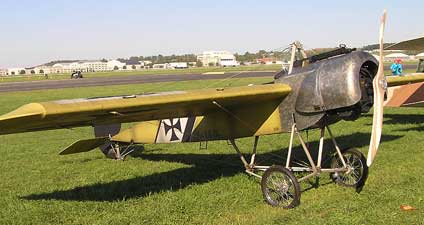 So in 1913 he had gone
to Paris and picked up a battered old Morane-Saulnier monoplane,
a light, strong, and agile design popular with French stunt pilots,
and had first rebuilt it and later evolved his own variants of
it. Such, essentially, was the E-I. The engine, an 80-hp Oberursel,
was also a German copy of the French Gnome rotary. The E-I had
a welded steel-tube fuselage of box section, fabric covered, with
a welded steel undercarriage below and king post above. Out from
the king post a cat's cradle of bracing wires stretched to the
wooden wings, whose ash spars and poplar ribs were deliberately
flexible, since the entire wing was warped by the pilot for roll
control.
So in 1913 he had gone
to Paris and picked up a battered old Morane-Saulnier monoplane,
a light, strong, and agile design popular with French stunt pilots,
and had first rebuilt it and later evolved his own variants of
it. Such, essentially, was the E-I. The engine, an 80-hp Oberursel,
was also a German copy of the French Gnome rotary. The E-I had
a welded steel-tube fuselage of box section, fabric covered, with
a welded steel undercarriage below and king post above. Out from
the king post a cat's cradle of bracing wires stretched to the
wooden wings, whose ash spars and poplar ribs were deliberately
flexible, since the entire wing was warped by the pilot for roll
control.
The pilot sat on a wooden bench, behind his machine gun, and he sat high above the wings, with no protection from bullets or the propeller's icy blast. Cockpit fittings were vestigial and rudimentary: on the left, a fuel-tank selector and a barometer to show altitude; on the right, fuel indicators and valves. The control column carried the gun button and a "blip switch," an ignition cutoff that was used to reduce power, since these early rotaries ran only at full power. No airspeed indication; the wind in the wires had to serve that purpose. This was by any standard a most primitive airplane. The top speed was around 80 mph. The engines regularly failed, the gun jammed, and even Fokker's famous interrupter gear would occasionally malfunction, so that the luckless pilot shot off his own propeller. (This happened to both Boeleke and Immelmann in combat.)
Along came the E-II, and the EIII with a more powerful engine and twin guns, and the E-IV with a big 160-hp, twin-row Oberursel that was so heavy it was almost a flying gyroscope.
No weapon lasts forever. While the B Fokkers had things all their own for a full year, the Allies in the end began to develop better scouts of their own. When Immelmann's Fokker monoplane came apart in the air it was the end of the E-type on the western front. From here on these planes were flown only in the east or for training.
Anthony Fokker was by now living a weird dual life. A self-made millionaire still in his mid-twenties, he lived modestly in a little German boarding house, his sole amusements outside his work being a pet monkey that stole things and a dog that would sit on the couch however often it was told not to. To his workmen he was der Alte-"the old man"- though he was still a fresh-faced youth. To his rival German aircraft manufacturers he was simply the enemy. Half his life Fokker spent at the front, visiting the squadrons that flew his aircraft, becoming the intimate friend of every German ace.
As these men respected his ability as a designer and pilot, so he adored them. "They were as different as men of the same breed can be," he wrote. "One by one I saw them die as I knew they must die, for they were in a contest not with a human opponent but with Time, the cruelest foe in the world. Judging their bravery by my own, I reckoned them supreme." Back in Berlin Fokker kept open house for the pilots, surrounding them with all the champagne and pretty girls they wanted. (So did every airplane manufacturer.) And while the pilots relaxed, in or out of their cups, Fokker listened avidly to every word they had to say about his designs, those of his rivals, and those of the Allies.
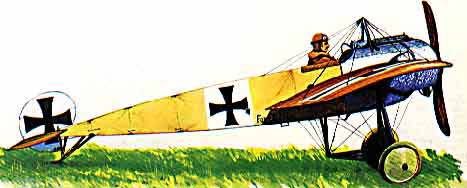 When the days of his E-types began to be numbered he came out
with several biplane fighters, with only indifferent success.
He was stuck with the damnable Oberursel engine; he'd even bought
the Oberursel factory. There was a vastly better engine: the 160-hp,
water-cooled, in-line Mercedes. Fokker thought it a better engine
than either the Rolls-Royce or the Hispano-Suiza, but he couldn't
get any. The Albatros factory, by jealous intrigue, had secured
the entire Mercedes output to use in their own airplanes.
When the days of his E-types began to be numbered he came out
with several biplane fighters, with only indifferent success.
He was stuck with the damnable Oberursel engine; he'd even bought
the Oberursel factory. There was a vastly better engine: the 160-hp,
water-cooled, in-line Mercedes. Fokker thought it a better engine
than either the Rolls-Royce or the Hispano-Suiza, but he couldn't
get any. The Albatros factory, by jealous intrigue, had secured
the entire Mercedes output to use in their own airplanes.
Greater power was out for the moment and so, therefore, was speed. Fokker decided to go hell-bent for rate of climb and maneuverability. The Fokker Triplane was the result. With its triple bank of wings, its clean lines, and almost total absence of wires and struts, it seemed almost to float in the air, and in Richthofen's words "climbed like a monkey and maneuvered like the devil." The Fokker Triplane was the vehicle of von Richthofen's immortality and also his death, but it was in fact used by few units and built in quite small numbers. Yet in the hands of a master pilot it was supreme. You could even make a flat turn in it, reversing your direction in four seconds without banking the wings. So maneuverable was it that Allied pilots never found out how slow it was and how short its range.
Fokker's Triplane was the first fighting airplane to use a thick airfoil section, which conferred upon it a gentle stall and excellent behavior at low speeds. It was in every way a cut above the F-type, having cantilevered wooden wings, cable-operated ailerons, balanced controls, and twin Spandau machine guns. It would hit 115 mph at low level.
Its climb rate was spectacular: under two minutes to 1,000 meters (3,280 feet) and only ten minutes to 4,000 meters, with a ceiling of almost 20,000 feet. Landing speed was a gentle 30 mph, but the airplane was almost impossible to keep straight on the rollout, and ground loops were normal. The airplane was extremely strong and would absorb a considerable amount of enemy fire, notably through having no bracing wires that could be shot away.
Still Fokker smarted under the successful machinations of his rival manufacturers, while the army acceptance board remained hopelessly obtuse to the advantages of his designs. He had to have that marvelous Mercedes engine. But how to break the Albatros people's stranglehold on its production? The pilots, Fokker knew, were ever his friends and allies. Could they help him? After all, their own necks depended on the quality of the planes they flew. He confided his problems to von Richthofen's technical officer and proposed a contest among all the manufacturers, whereby a delegation of crack fighting pilots would choose the best airplane-the one to be built in quantity. Quickly the idea was approved and accepted. And part of the contest rules was that every contestant should use the Mercedes engine, to make things fair. At last Fokker got his hands on one!
The trials began on January 18, 1918, a good day for flying, surprisingly mild for the time of year, and almost clear, with but a thin cover of cloud at 13,000 feet against which the darting machines would show to advantage. Fokker came determined to win bringing eight different designs with him. The competing manufacturers vied with each other in lavishly entertaining the pilots. Many of the younger pilots were so hung over they could hardly fly, and numerous valuable prototypes were casually wrecked in landing and taxiing accidents. From this sad and disreputable scene one proud figure stood out, his integrity and conduct above reproach: von Richthofen.
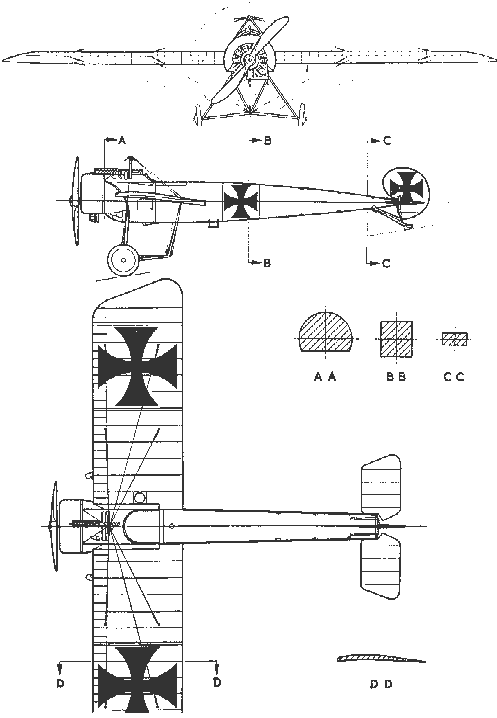 Yet
when the Bloody Baron chose to test one of the Dutchman's designs
first, word went quickly around that he was "sold on Fokker."
He was not. The airplane, he reported, was maneuverable and performed
well, but it was directionally unstable and altogether vicious
at the stall. Fokker, who was if nothing else a test pilot of
pure genius, knew in his heart that von Richthofen was right.
"A slight landing accident," Fokker announced, wheeling
the machine into a hangar and secretly summoning two of the best
welders from his factory.
Yet
when the Bloody Baron chose to test one of the Dutchman's designs
first, word went quickly around that he was "sold on Fokker."
He was not. The airplane, he reported, was maneuverable and performed
well, but it was directionally unstable and altogether vicious
at the stall. Fokker, who was if nothing else a test pilot of
pure genius, knew in his heart that von Richthofen was right.
"A slight landing accident," Fokker announced, wheeling
the machine into a hangar and secretly summoning two of the best
welders from his factory.
As with the interrupter gear, they worked through the night and over the weekend, laboring like gnomes in the cavernous darkness of the hangar, lit only by the violet glitter of the welding torches, cutting the fuselage in half to weld in another two-foot bay, and enlarging the fin. Thus was an airplane "designed" in those happy days. In truth the fuselage Fokker had started with was an almost standard one off the Triplane production line. The longer span of the biplane wings was simply too much for it.
Some adjustments had been made to the control gearing, he hinted, when Monday came. Would Herr Rittmeister care to try it again? He would find it much easier to fly, though its special quickness on turns was still a notable feature of the ship. Von Richthofen was very amazed that mere 'adjustment' could so improve an airplane. It was now quite free of vices and a delight to fly. The Baron's colleagues agreed with him. General von Hoeppner, chief of the German air service, took Fokker to one side. "How many planes could you build at once, Herr Fokker?" he asked. Fokker answered irritably that his works were filled with some wretched A.E.G. training planes he had been ordered to build. "Let us not waste time quarreling," said the general forcefully.
"What would your price be for four hundred of the new planes?" Fokker could hardly believe his ears! It was an order of staggering size. He named his price, 10,000,000 marks, and got it. But even more joyful news was to come. His hated rivals, Albatros and A.E.G., were ordered to build his design and to pay him a royalty on each and and every one! Thus did their greed in gobbling up all the Mercedes engine production backfire. Fokker had hoped to stage a comeback, but never anything like this.
No time was lost in starting production. Fokker, of course, had no formal plans for his new design, which he named the DVII, and he had to lend the prototype to the rival factories so they could copy it. (Production quality and control were never Fokker's strong point. An Albatros-built D-VII was always a better airplane than ever came out of Fokker's own ramshackle works.)
The first combat D-VII was delivered to von Richthofen's unit a bare two months after the trials at which it had been chosen. While the Baron was seen flying it when visiting nearby units, for combat he stuck to his legendary blood-red Triplane in which he died. Yet news of this latest Fokker scourge spread swiftly among Allied pilots. Here was a seemingly magical airplane, with strange thick wings and almost no struts, which seemed to be able to stand still in mid-air while spitting a deadly stream of lead from its twin Spandau's into the soft and unprotected underbelly of its victims as they sought to climb out of its range.
Somewhere around a thousand DVII's had been built by the time of the armistice, and many famous pilots flew them, not least Hermann Goering, that sorry successor to von Richthofen as commander of JG- 1, and a figure who was to achieve a wider fame before his ignominious death from a cyanide pill in a Nuremberg cell twenty-seven years later.
In all the world perhaps two original Fokker D-VII's are still flying. The one depicted here is the proud property of Cole Palen, of Old Rhinebeck Aerodrome, New York. We asked him how it flies. "Like a puff of warm air," was his graphic answer. "It'll break ground for no reason at all, without nosing up or you making any real effort. It just floats away. I would say it's very sensitive on the elevators- so many of the early machines were. And it's a rudder airplane. Give it rudder and automatically you're going to get the right angle of bank to make your turn. The ailerons are there just to keep the angle of bank where you want it.
"The stalling speed I would guess to be about 40 to 45 mph. It stalls pretty much straight ahead, without undue wing-dropping."It will definitely ground-loop, though it's not so bad as the Triplane. But you do have to land into wind; this applies to almost any of the early airplanes. But I would say it is the easiest flying of the World War I fighters. I think it would compare favorably with a Piper Cub, except for that damn rollout.
"From my machine I don't think it was as fast as Fokker claimed. I don't think it ever could go more than 100 mph. Like the Triplane, it was the kind of airplane you couldn't very well run away from a fight in, but its exceptional characteristic is its rapid rate of turn. It will out-turn anything else I've flown. And that story of D-VII's being able to hang on the propeller and still fly is absolutely true. It will hang at about forty-five degrees and still be in full flight and very controllable. The vertical reverse and the Immelmann are very nice, and the Lufbery circle is very rapid.
"The engine is reliable, though I think mine is turning unusually slowly. It isn't giving quite the power these days that it used to. I get about 1,270 rpm when I should get 1,400.
"The engine is a high-compression straight-six in-line. The carburetor air is crankcase warmed, and it has a dual ignition- and in a sense dual carburet ion-for there are two bowls and jets each feeding three cylinders. You can almost fly on three cylinders. Well, you can't really, but you can make a very long glide.
"The engine starts itself, without a starter, and you
don't have to crank it. You just pull the propeller through a
few times with the engine on low compression, and you can hear
the carburetor drawing, sucking gas, and then you turn it over
a few times till you know you've got a good mixture in the cylinders.
Then you wind the old Bosch hand crank to make a spark, which
goes through the distributor and into a cylinder. It may kick
backwards at first, but it's got sense and eventually it will
settle down and run properly. It will idle very slowly. We can
keep it running at 150 rpm.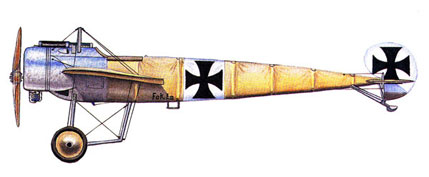
"Would you believe. I am still using original World War I spark plugs?"
The entire contents of his factory were quickly hidden in barns and lofts for miles around. Then he devised the 'preposterous, unholy, impossible plot of smuggling all these airplanes over the border into his native and neutral Holland. More than 400 engines and 220 complete airframes, including 120 D-VII's were loaded into six trains, each one made deliberately too long for any sidings, and spirited across the border. How was it done? With bribes-20,000 guilders' worth. It is a curious thing that if you take as cynical a view of the world as Anthony Fokker did, the world has an uncanny habit of proving you right.
Fokker, still only twenty-eight, had also built up a cash fortune of some 30,000,000 marks (about $7,000,000), and he was able to smuggle out most of this by converting it to foreign currency and packing it in old suitcases or aboard his yacht.
The D-VII's were sold to many countries: Holland, Belgium, Poland, Sweden, Denmark, Italy, Spain-some of them by Goering, now Fokker's sales agent. (Goering's new job did not last long. His expenses proved far too lavish for Fokker.) Of those plundered by the Allies no fewer than 142 were shipped to the U. S. Army designers were urged to study the type, and the wonderful performance of the Mercedes engine was praised.
D-VII's served with the U. S. military for several years, and they were preferred by their pilots to the SE-Sa's also in use. Eventually lack of spare parts forced them off the inventory in the mid-twenties, though D-VII's continued to fly in Holland until 1939.
But was that even the end of it? Ghostly galleons are still sometimes seen sailing the misty seas; phantom highwaymen are still midnight-galloping across their windy heaths; and embattled armies are still somehow heard, when the wind is right, clear across the centuries. In the cloudy skies of eastern France, above fields where trenches once snaked like open wounds, might not the clatter of a Mercedes and the chatter of twin Spandau's be heard? Perhaps.
|
This model and description was send in by Dave (flypaper) Caldwell |
When Germany mobilized for war Immelmann was posted to his old regiment but succeeded in transferring to the Fliegertruppe. In November he reported to the flying school at Adlershof and by March 1915 he was passed out as a pilot. The start of his active service was inauspicious when he cracked up two LVG two-seaters in heavy landings but his great chance came when in May he was transferred to Fl Abt 62 at Doberitz and thence to Dubai where he and Boelcke began their unique partnership.
On 4 June, flying an unarmed LVG on a photo reconnaissance mission, Immelmann was engaged by an armed Farman and a lucky French bullet sheared his ignition. He brought his powerless aircraft safely down in a field near to base and for the feat received the Iron Cross Second Class. He was still in Boelcke's shadow however and when his friend and rival received an armed Albatross C I his LVG equipped with a lashed-up Hotchkiss was passed on to Immelmann. When Boelcke got a new Fokker EIII, Immelmann took over the Albatros. On 30 July 1915, as a newly promoted Lieutenant he flew a two-seat Fokker M8, an unarmed reconnaissance monoplane but similar to the Eli I.
Early on the morning of 1 August, Abt 62 was roused from its slumbers by the sound of roaring engines and the crump of bombs. Ten RFC BE2cs were beating up the airfield and, by the time Immelmann had sprinted to Boelcke's second Fokker EIII, the British were on their way home. Boelcke got up in pursuit wearing his nightshirt while Immelmann quickly found his way round the unfamiliar machine. Boelcke never fired a shot. He had to turn back with his machine-gun jammed. The Saxon however caught up with the rearmost BE2c near Vitry and fired off some sixty rounds before his machine-gun jammed. Then the British aircraft went into a spin, its pilot wounded in the arm, but landed safely and Lieutenant Reid RFC was taken prisoner. He was Immelmann's first victim.
For this feat Immelmann got the Iron Cross First Class and on 25 August he and Boelcke brought down a Caudron GIV. The next day Immelmann flying alone made his second kill and the day after came another claimed as a Bristol two-seater. More victories followed and in this period of ascendancy Immelmann was able to work out the tactics, including the famous maneuver that became known as the Immelmann turn, that a single-seat fighter armed with a forward-firing machine-gun allowed. It was Immelmann also who set the pace for using the Fokker offensively by aggressive patrolling and stalking Allied machines that crossed the lines. In October Boelcke was detached for bomber escort to Metz and Immelmann became the sole defender of the highly important communications center of Lille, wherein he gained two more victories to become an 'ace'. When the first Kampfeinsitzer Kommandos were formed, Immelmann led his unit at Dubai while Boelcke was at Sivry. Both men received the Pour le Mirite in January and their fame and exploits were trumpeted throughout the Reich.
Inevitably by the spring of 1916 the Fokker monoplane's advantage was eclipsed by new Allied types but the designer strove to keep the edge. Immelmann tried an EIII with twin machine-guns but twice the interrupter gear failed and he shot his own propeller off. He tried the bigger EIV with a twin-row rotary and mounting three machine-guns but it was so heavy and slow that he soon reverted back to the 100 hp EIII.
By June 1916 the air fighting over Verdun was proving as bloody a mincing machine as the battle on the ground and the British push on the Somme was about to start with great superiority in numbers of aircraft. The Eindecker's advantage had been more than checked. Great things however were hoped of the new jagdstaffeln and the skill of Immelmann and Boelcke still held the morale of the air service and indeed the German people high. Then on the morning of i8June Immelmann took off with three other pilots to patrol a sector near Lens. He never came back. His aircraft broke up in mid-air after a fight with seven British FE2bs of No 25 Squadron. There are three versions of how it happened. The British records indicate that Corporal J H Waller firing a Lewis from the FE's front cockpit simply shot him down. The second is that anti-aircraft fire was responsible and the third that once again the Fokker's primitive synchronizing gear had failed and the Saxon ace had 'shot himself down'. Whatever the cause it was a severe blow to German morale and signaled the end of the Fokker ascendancy that Max Immelmann had done so much to ensure. The 'Eagle of Lille' had taken fifteen Allied aircraft with him.
The air supremacy enjoyed by the Fokker monoplane fighters over the Western Front must have been more than usually galling to the French in particular, for the Fokker E types design was influenced by the Morane-Saulnier Type II monoplane, and they carried an interrupter gear developed by Fokker's engineers after capturing Roland Garros' Morane-Saulnier Type L. The Fokker M.5 which gave rise to the E types was first flown in 1913. From it were developed the long-span M.SL and the short-span M.SK. Both were powered by the 8Ohp Oberusel rotary and used in modest numbers early in the war; a few M.5Ls served with the Austro-Hungarian air ann.
Following the capture of Garros' Morane L in April 1915,
Fokker engineers developed an interrupter gear that was tested
on an M.5. Two other M.SKs were similarly tested using a Spandau
gun, and this version went into urgent production as the E.I;
front-line units began to score mounting successes as their EI's
were delivered from June 1915, and production is believed to have
totaled sixty eight. The El, essentially a 'rush job', was quickly
followed by the ElI in which the 100 hp Oberusel was installed.
Other ElI modifications included a reduction in wing size, which
made it more difficult to fly without any appreciable increase
in performance. Deliveries, of about fifty E.fls, began in July
1915. The most numerous version was the EJIT, with wings extended
to a span greater than the original El. The E.III was normally
fitted with a single 7-92mm Spandau gun; a few were flown with
twin guns, but the extra weight imposed an unacceptable penalty
on performance. 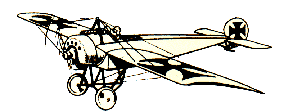
Two hundred and sixty Ellis are thought to have been completed, being used by the German Army and the Austro-Hungarian Air Service, which had also received a few Ells. An attempt to produce a viable two-gun fighter resulted in the Ely, whose prototype appeared in November 1915. This was given a 160hp two-row Oberursel, and the wings were further extended to 32ft 9 in (l000m). However, the E.IV, although faster than the EIII, proved to be much less maneuverable, and only about forty five were built. For a brief period Max Immelmann flew a three-gun E.IV, but he later reverted to a standard two-gun machine. In E types serving with the Austro-Hungarian forces the domestic 8mm Schwaxzlose gun was usually substituted for the Gennan weapon.
The Fokker E types were in service on the Western Front from mid-1915 until late summer 1916. Their peak period of effectiveness began about October, and from then until January they reigned virtually unopposed in European skies. This lack of opposition led to the almost legendary success of the Fokker scourge', which was out of all proportion to the actual numbers in service. Their chief victim was the luckless &EIc, which soon earned a reputation as Fokker fodder'. From January 1916 the Fokkers began to encounter worthier opposition in the fonn of the D,H.2, Nicuport II and F.E2b, which had virtually dispelled the Fokker's menace by the spring. The E types continued until the end of 1916 on the Eastern Front and in Mesopotamia, Palestine and Turkey, but thereafter were used almost exclusively for training.
If French pilot Roland Garros had not been shot down near Courtrai on 19 April 1915, or if he had been luckier in his attempts to destroy his aircraft, the world would probably have heard little of the Fokker Eindecker, for it was then in service only in small numbers as a fast communications aircraft. But with the capture of Garros' special Morane-Saulnier Type L parasol monoplane, Germany gained possession of the first device to be used in air combat that enabled a machine-gun to fire through plates and to deflect those bullets which struck the blades; but Luebbe, Heber and Leimberger, three of Fokker's engineers at Schwerin, went one better. Adopting, in essence, the principle of letting the propeller fire the gun, they came up with a mechanical interrupter' gear which adjusted the rate of fire to the propellers rate of turn, i.e. firing was interrupted as a blade passed in front of the gun. in the hands of such leading pilots as Oswald Boelcke, Max Immelmann and others, the Fokker soon became a formidable fighting machine, successes mounting as the number of aircraft in service increased.
The hastily-produced E.I was quickly followed by the Eli with powerplant and other improvements, and by the principal service version, the Elli. The first recorded Eindecker victim, probably a B.E.2, fell near Dubai on 1 August 1915 to one of the prototype aircraft flown by Immelmann. In October the so-called Fokker scourge' began in earnest, and throughout the ensuing winter, against negligible Allied opposition, they gained a reputation for deadliness far in excess of their true military value. Many of their victims were variants of the two-seat B.E.2, an otherwise worthy aeroplane that just did not have the speed or agility to get out of their way. But in January and February 1916 Allied squadrons in France began to re-equip in strength with D.H.2, F.E.2b and Nieuport II fighters, and the decline of the Fokkers' reign of supremacy began. The EIII illustrated is the only genuine example of its kind still known to exist, though one has been reported in East Germany.
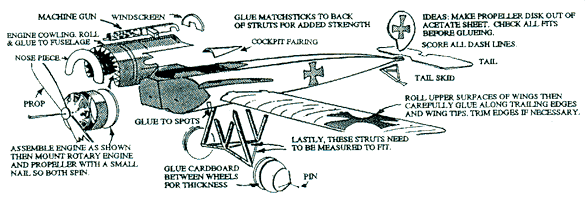
Specifications for the FOkker E.III
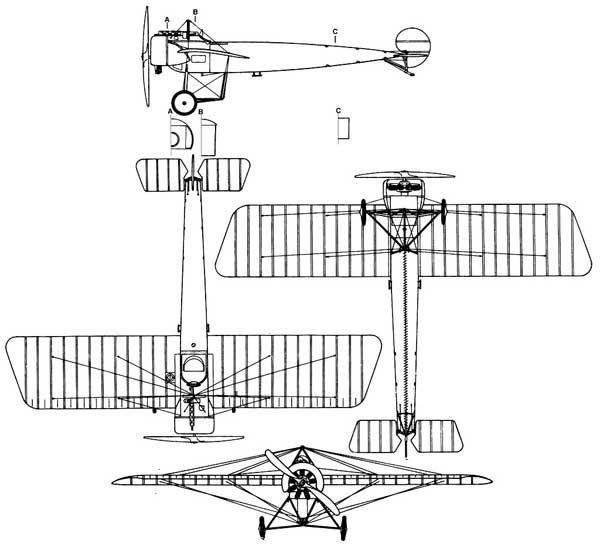 |
Length: 23 ft 11 in Wingspan: 32 ft 11 in Height: 8 ft 2 in Loaded weight: 770 lb Powerplant: 1× Oberursel U.I 9-cylinder air-cooled rotary engine, 100 hp Performance Maximum speed: 93 mph Range: 220 mi Service ceiling: 11,810 ft Endurance : 2 hr 45 min Armament 1 × 7.92 mm (0.312 in) MG 08 machine gun |
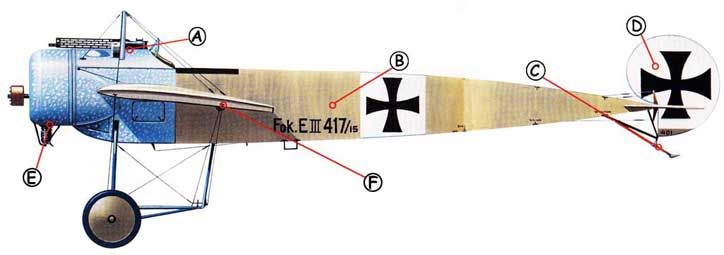 |
||
| A: The single LMG 08/15 Spandau machine gun combined with synchronizing gear to give the aircraft a decisive combat advantage. | B: Stretched and doped fabric covered the steel tube framework of the fuselage. | C: The steel tube supporting the tailskid also acted as the lower pivot for the rudder. World War I operations were carried out under harsh conditions and aircraft had to absorb much abuse. |
| D: The pilot had to maintain constant pressure on the rudder pedals to keep the all-moving vertical tail surface steady. | E: A cut-out was made in the lower cowling so that any fuel leaking from the engine while at rest would not puddle and catch fire when the engine was started. | F: Roll control was provided by wing-warping. Cables connected to the pilot's control column literally bent, or warped, the wing in response to his control inputs. |
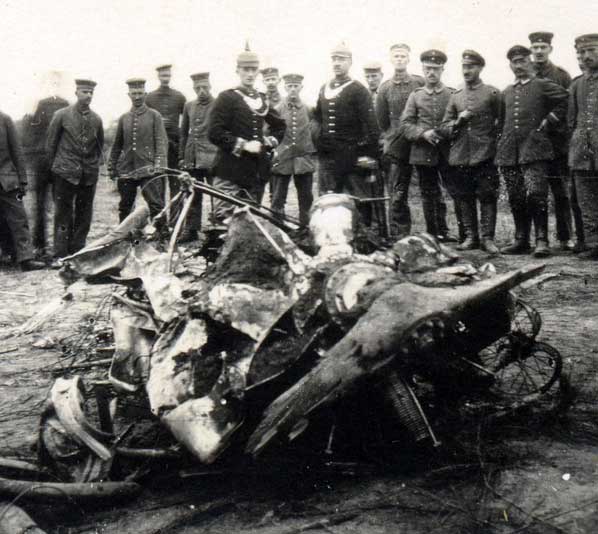 |
Wreckage of Max Immelmann's Fokker E.III being guarded by Feldgendarmerie. |



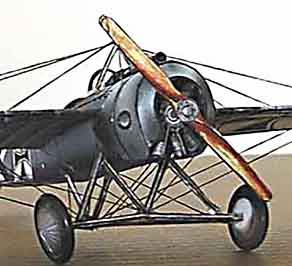 And
here is a .jpg (not .bmp) of the finally completed Eindecker.
My engine technology is improving. This one is 9 little pieces
of bamboo skewer wrapped in silver paper that I drew cooling
fins on (I know I can do better next time!).Rods are just pieces
of wire. I sandwiched the bamboo between the centers of Chip's
engine front and back. Didn't get them exactly even. Need to
adjust the length of my wooden cylinder heads just a tad so I
can get a nice round look.This one doesn't rotate - one cylinder
hits the cowling. Wires are just thread.
And
here is a .jpg (not .bmp) of the finally completed Eindecker.
My engine technology is improving. This one is 9 little pieces
of bamboo skewer wrapped in silver paper that I drew cooling
fins on (I know I can do better next time!).Rods are just pieces
of wire. I sandwiched the bamboo between the centers of Chip's
engine front and back. Didn't get them exactly even. Need to
adjust the length of my wooden cylinder heads just a tad so I
can get a nice round look.This one doesn't rotate - one cylinder
hits the cowling. Wires are just thread.